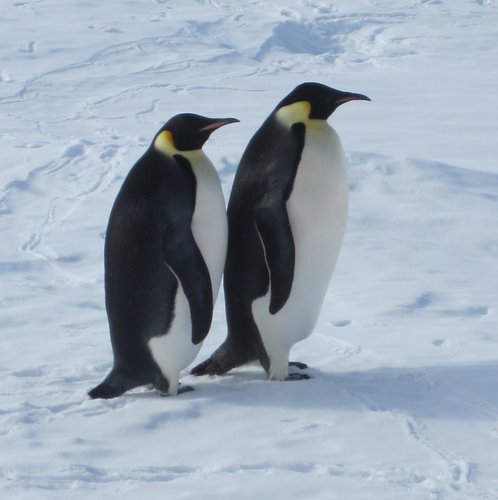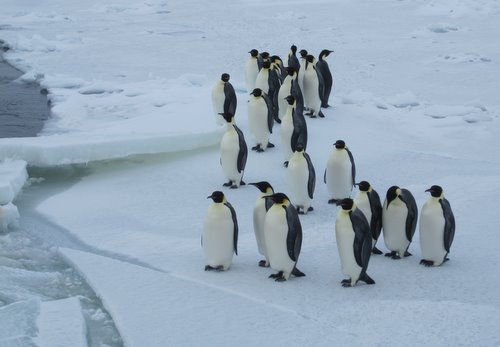Speed 5.8 knots (kts)
Course 250°
Location En route to the Larsen A (-64.94670167, -58.52958667)
Depth 434 m
We're moving back into the Larsen A, which means we are headed west towards the Antarctic Peninsula. Everything is covered in ice and we are making our way by breaking thin ice that the ship can easily get through. Before I left, everyone asked for lots and lots of penguin photos so I have some more to share with you.
Emperor Penguins
While we were on station a bunch of curious Emperor Penguins came over to visit our ship. Apparently, this isn't that uncommon and they frequently will come close to large ships and get rather close. At first, there were only a couple of penguins that meandered next to the boat.
 Two Emperor Penguins
Two Emperor Penguins
Two Emperor Penguins
Emperors are the largest penguins and have characteristic yellow-orange patches on the side of their necks. They're really beautiful creatures and most of the ones we saw were probably about 3-4 feet tall. One of the best parts of watching penguins is seeing how they move on land. They waddle when they walk and then they get on their stomachs to glide along the snowy surface to move more quickly.
 Emperor penguins walking and gliding
Emperor penguins walking and gliding
In order to get up from sliding on their stomachs, they often use their beak to prop themselves up. From the pictures below you can see the penguin on the left standing up using its wings and the penguin on the left standing up using its beak.
 Standing up from their stomachs
Standing up from their stomachs
Although we started out with only a couple penguins, on the last day at station about twenty Emperors greeted us in the morning. It was crazy to see so many in one place at one time.
 A whole bunch of penguins
A whole bunch of penguins
Although penguins move surprisingly slow on land, they are extremely adept swimmers. At one point, almost all of the penguins were swimming and playing in the water behind our boat. In the video below, check out how graceful they are once they are swimming and try to spot them zooming around underwater.
http://

